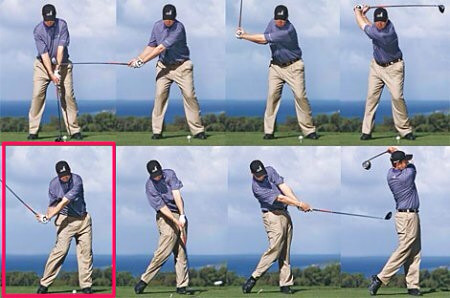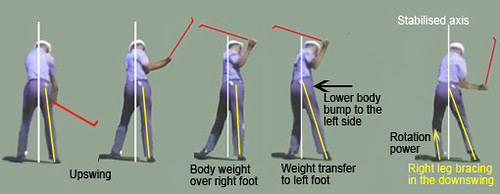One of a golfer's biggest potential errors is to get lazy and fail to shift or transfer the weight FULLY to the left foot before starting down. We all know we're supposed to do it--bump to the left and then rotate. Sometimes we think we're doing it when we really aren't. Some can get part way over at impact but not far enough; the weight ends up, maybe, in the center of the stance to the inside of the left foot at impact. Maybe it stays more on the right foot than imagined. Usually, it's because we're working on some other part of the swing and become distracted from this absolute essential fundamental. All sorts of wayward shots result, including slices and fat shots.
The reverse pivot is the other golf weight shift evil that's far worse than failing to get fully to the left; these folks (fortunately not my problem) do it all backwards; they shift their weight left on the backswing and then right on the downswing, all the while thinking they're doing it correctly. You'll know them by the way the lose their balance and fall backward at impact, with more weight on the right foot at the finish than at address. Sometimes you'll even see them take a step backwards with the left leg!
To get an idea of what "correct" feels like, use Shawn Clement's One Leg Drill to exaggerate the feeling of pivoting in a centered fashion and being firmly onto the left side to begin the downswing. At impact, most of the weight should be on the left foot. This is what is often called "hitting into a firm left side or left leg." Shawn calls it "bracing one's tilt against a firm left side." The inside of the right leg and foot should be the pivot point for a centralized backswing (with most weight movement to the right provided by the arms and club only--not a conscious shifting of body weight to the right), and the left foot and leg should be the pivot point for the downswing! The right leg's main function at impact is to ensure the tilted upper body doesn't fall over while mostly supported by the left leg. So, a key part of a great forward weight transfer is ensuring that you don't move too far off the ball to begin with! Make a centralized turn (you shouldn't move more than an inch of so off the ball during the backswing weight "shift." (really more of a turn than a shift) All sorts of GREAT shots result when getting off the right side by impact, such as power, slight draws, easier fades (with the right stance and grip adjustments), low shots played further back in the stance, hitting down, crisp contact, lower ball flights, great wedges, etc. The finish will be fully over the left side, with the weight concentrated toward the outside of the left foot, like it's supposed to be.
 |
| Notice frame 5 - shift before arms come down! |
Other drills to instill this feeling include Gary Player's "hit and take a step after impact" drill and completely lifting the right foot off the ground at the finish while remaining balanced on the left foot. Either of these makes the point that the right leg should have minimal involvement in supporting the body weight at impact and beyond.
Here's another feel to get the point of shifting into a solid left leg and stable left foot: When bumping the left hip targetward, act as if the left foot becomes firmly planted onto the flat surface of a foot stool and that the next act has one stepping up by straightening the left leg while rotating to put something on a shelf behind and above oneself. All of this should be happening while the arms are still at the top or nearly there! Don't start down with the arms before planting into that left leg, because that left leg is the power engine for the arms to accelerate from the ground up! Get the feeing that your hands and arms are lazy and kind of pause at the top (with the back turned), while you shift firmly into the left leg. In reality, the club head will keep going for a second and set at the top while you shift. The head should stay tilted back behind the ball.
 |
| Shift into left leg then fire! |
Characteristics of a proper weight transfer during the downswing: The weight shifts linearly (targetward) into the MIDDLE of the left foot, BEFORE opening the shoulders and starting down with the arms and club. As the left hip bumps towards the target, there's a distinct, solid feeling in left hip and bent left knee, as the weight settles into the left leg (again, before starting down with the club), though the upper body is tilted away from the target. The bent left knee will shift from pointing behind the ball to pointing ahead of it, automatically. The right knee will fold in (again, linearly) behind the left knee, automatically. When the weight first transfers quickly to the left foot, the left knee is bent but gradually straightens as the left hip gradually rotates backwards and upwards during the remaining downswing motions (the left hip rotates upwards because the left knee straightens). This move is NOT abrupt or "stomping" in nature; it's a very smooth but rapid transition into the left foot (almost a pressing down feeling) that gets the weight left. At impact, there's practically no weight on the right foot. The weight will be firmly in the middle of the left foot at impact and will gradually roll to the outside of the foot at the finish.
The weight transfers in the swing purely due to the motion in the arms hands and club as they travel away from the target. Think of it this way – if I swing my arms, which each weigh 15 lbs, and a club in my backswing you can be sure that I am transferring weight onto my back foot. There is however no conscious shifting or body move that gets the weight over there.
There is no lateral body move, yet many players often wrote or spoke about a sense of weight transfer. The body stays centered while the weight is transferred by the motion in the arms and the club. Video HERE
All the best ball strikers studied displayed a tendency to transfer the weight to the front foot in a smooth and continuous flow with no backing up or slowing of the transfer...This meant that they arrived at impact with an 80/20 split favoring the front foot and the weight continued to move smoothly over to the front side beyond impact.
The tendency with higher handicap golfers (above 18) was for the weight to get too far back and then remain there all the way through impact. It was not unusual to see one of these golfers have a split of 70/30 favoring the back foot at impact.
The hips play a very important role in the golf swing. The problem is that most people do not understand the correct motion that they must make. The correct move is NOT a simple turn of the hips from the top of the swing, as many would believe.
In fact, the correct move is a slight lateral shift, or "bump", and then a turn. If you look at players like Tiger Woods and Nick Faldo, you will see a perfect example of this. These guys don't just turn their hips away from the top. Instead, their weight shifts laterally to the left side, which drops everything (arms and shoulders) into the slot. From there, they can just turn and fire through the ball as hard as they want.
Golf Tips - Hip Movement During the Swing
Secondly, good ball-strikers make a full weight transfer to the left as they complete their swing. You can't finish low if you hang back on your right side. Proof of the weight shift is your right heel.
If you've turned your hips aggressively and moved to your left side through impact, your right heel should be off the ground and closer to the target than your right toe.
Stay Low After Impact - Butch Harmon
Start the downswing by stepping down on your left heel and letting your left hip move slightly toward the target. As your lower body starts to move, pull your hands down, keeping your right elbow close to your right hip as long as possible.
Take our advice: Put your golf slice in the past
This “bump then fire” action, which is present in the techniques of many elite players, requires considerable discipline in ensuring that the weight transfer is properly executed before commencing the downswing rotation.
No comments:
Post a Comment